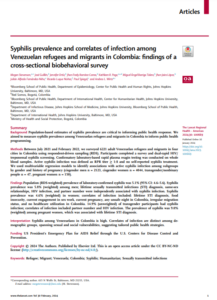
Background
Population-based estimates of syphilis prevalence are critical to informing public health response. We aimed to measure syphilis prevalence among Venezuelan refugees and migrants in Colombia to inform public health programming.
Methods
Between July 2021 and February 2022, we surveyed 6221 adult Venezuelan refugees and migrants in four cities in Colombia using respondent-driven sampling (RDS). Participants completed a survey and dual-rapid HIV/treponemal syphilis screening. Confirmatory laboratory-based rapid plasma reagin testing was conducted on whole blood samples. Active syphilis infection was defined as RPR titer ≥ 1:8 and no self-reported syphilis treatment. We used multivariable regression models to identify associations with active syphilis infection among subgroups by gender and history of pregnancy (cisgender men n = 2123, cisgender women n = 4044, transgender/nonbinary people n = 47, pregnant women n = 150).
Findings
Population (RDS-weighted) prevalence of laboratory-confirmed syphilis was 5.1% (95% CI: 4.6–5.6). Syphilis prevalence was 5.8% (weighted) among men; lifetime sexually transmitted infections (STI) diagnosis, same-sex relationships, HIV infection, and partner number were independently associated with syphilis infection. Syphilis prevalence was 4.6% (weighted) in women; correlates of infection included: lifetime STI diagnosis, food insecurity, current engagement in sex work, current pregnancy, any unsafe night in Colombia, irregular migration status, and no healthcare utilization in Colombia. 14.9% (unweighted) of transgender participants had syphilis infection; correlates of infection included partner number and HIV infection. The prevalence of syphilis was 9.0% (weighted) among pregnant women, which was associated with lifetime STI diagnosis.
Interpretation
Syphilis among Venezuelans in Colombia is high. Correlates of infection are distinct among demographic groups, spanning sexual and social vulnerabilities, suggesting tailored public health strategies.